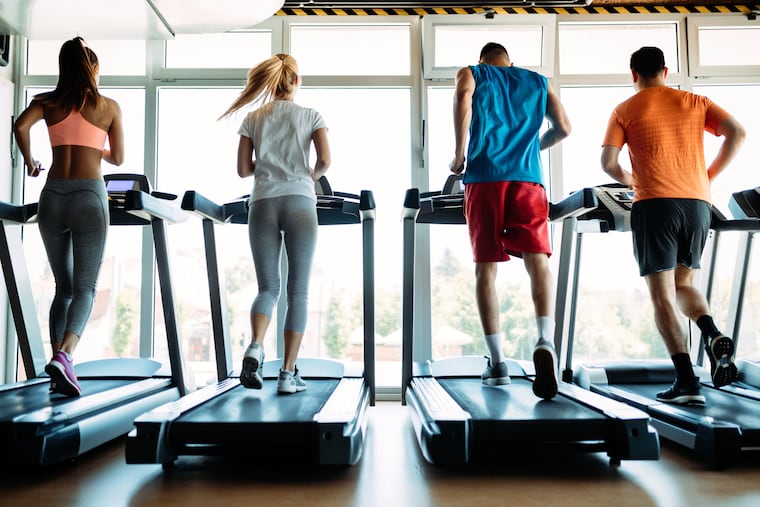4 tips for safely using a treadmill
Despite how rudimentary this running machine appears, many unknowingly misuse it. That’s why it’s important to brush up on the safety guidelines necessary to stride safely on these fast moving machines.

Could your treadmill technique use some tweaking? At a glance, this cardio contraption seems simple enough to operate. You hop on, press start, and begin marching until you reach your targeted time or mileage. But despite how rudimentary this running machine appears, many unknowingly misuse it.
It may surprise you to learn that, each year, exercisers are critically injured from improper use of aerobic equipment such as treadmills. That’s why it’s important to brush up on the safety guidelines necessary to stride safely on these fast-moving machines. Whether you are new to the aerobic scene or just want to get a running start on your 2020 health goals, the following fitness rules are a must for making the most of your next treadmill session.
Learn the basics
When first stepping onto the treadmill, before pressing start, straddle the belt and familiarize yourself with the controls. The two most valuable safety buttons are “stop” and the emergency stop mechanism — look for the string twisted around the handrail and fasten it to your shirt. In the event you feel lightheaded or dizzy and need to terminate your tread time, hit the “stop” button right away. If you are unable to hit that button, the emergency stop device will bring the machine to an immediate halt.
Hold the handrails for support and step onto the belt. Press start and slowly increase your speed. Avoid jumping onto a moving machine, as doing so increases your risk of falling. Walk for 30 minutes at a speed that feels safe for you.
The handbook on handrails
One of the most common cardio mistakes made by treadmill users is hanging on to the handrails, or the top of the machine, while walking, running, or moving at a steep incline.
These supports are best suited for beginners, those with balance limitations, and anyone who needs extra stability while walking at a slow pace. For everyone else, grasping the machine, especially at higher speeds, impairs the body’s ability to move naturally. This zombie-like stance causes the back to hunch, chest to cave forward, breathing quality to diminish, and core muscles to miss out on the workout, and even curtails your caloric expenditure because you are unable to fully exert yourself.
For the body to propel itself forward properly, the arms and legs must move in unison. When the arms pump quickly, the legs respond by keeping up the pace. But when the arms are planted on the treadmill, kinks develop in the body’s kinetic chain.
The safer, more effective alternative is to calibrate the treadmill settings to a speed and incline that allow the limbs to flow freely. If you need to hold the handrails to keep up with the speed and elevation, it’s probably an inappropriate setting for you. Walking and running on a treadmill should always mimic the same movements performed outside of the gym.
Pace yourself
You just mounted your treadmill, your motivational music is on, and your fellow cardio competitors on the neighboring machines look strong as they sprint through their workout. You haven’t run in several years, but the amped-up tempo of the aerobic atmosphere is contagious and now you want to increase your speed, too.
Although it may be tempting to keep up with the jogging Joneses, you must walk before you can run. Even if you walk or jog outside occasionally, the treadmill is a different experience and the body needs time to acclimate to new cardio conditions. For first-timers, focus on a comfortable pace that allows you to walk without holding the handrails, and feels good on such sensitive joints as the knees, hips, and ankles. For more of a challenge, increase the incline in small increments each time you exercise to build endurance.
Also keep in mind that you will inevitably encounter the daredevils who dance, jump, twist, and twirl on the treadmill. While they are entertaining to watch, you must steer clear of these Evel Knievel-like moves because it takes only one misstep to end up in the emergency room.
Ditch the distractions
When the brain is multitasking, the body is more likely to lose control. Dangerous distractions such as cellphone scrolling, magazine reading, and television channel surfing can jeopardize your balance, increasing your risk for falls and deadly brain injuries.
We all know that treadmills can be boring, so it makes sense to seek entertainment. But for this to be done safely, organize your favorite shows, playlists, or podcasts prior to pressing “start” to ensure hands-free and hassle-free use. It’s also wise to put your phone on a “Do Not Disturb” setting to reduce disturbances that can divert your attention.
Remember, your workout is your personal time to grow, unwind, and recharge. Most calls and texts can wait until you’ve completed your 30-minute session.
Ashley Blake Greenblatt is a certified personal trainer and wellness coach. To learn more about her virtual training program, visit ashleyblakefitness.com.